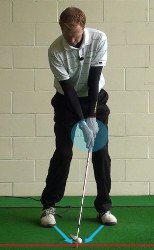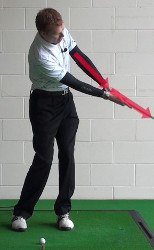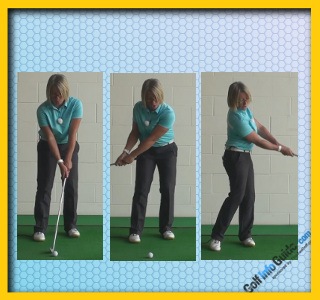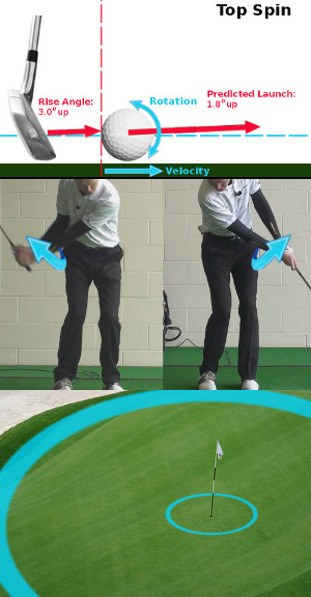
When you're faced with a long chip with plenty of green to work with, the best play is to get the ball on the green and rolling as quickly as possible.
If you're just off the green, using a less lofted club, like a 7-iron, is a good idea. But if you're farther from the green and need to carry the ball a decent distance, more loft is called for.
More loft equals a higher shot with more spin – so how do you produce the roll needed to get the ball to the hole? It's all in the release. By letting the right hand turn over the left through impact, you decrease backspin. Here's how it's done:

- Using a gap or sand wedge, assume your normal setup for a chip or pitch shot, but place the feet wider – with the heels 6-8 inches apart.
- Play the ball in the middle of your stance.
- Hold the club with a slightly “strong” grip, with the hands turned to the right on the handle.
- As you swing through, allow the right hand to overtake the left, finishing with the club's toe pointing up and the left elbow folded.

When hit properly, the ball won't check sharply after landing and stop well short of the hole. Instead, it will bounce and run toward the cup.

Release Club to Hit Running Chip Shots
If there is one area of the game where you need variety in order to be successful, it is the short game. Simply put, only knowing how to play one or two kinds of chip shots is not going to get the job done. You are going to encounter many different situations when you make your way around the golf course, and you need to have a number of different shots available to get through a round. In this article, we are going to highlight one specific kind of chip shot – the low, running chip. This won't always be the right play for the shot at hand, but it will be great to have in your arsenal when the need arises.
Too many golfers get stuck in a rut when it comes to the kinds of shots they are willing to use to get the ball close to the hole. Once you get comfortable with one or two 'favorite' shots, you might find that you continue to use those over and over again – even if they aren't always the best choice at the time. While there is nothing wrong with having favorite shots, you don't want to become so reliant on those that you never bother to learn any other options. Playing consistent golf requires a well-rounded approach that leaves you prepared for whatever the course happens to throw your way.
Before we get into the details of using a running chip shot, and why it can be such an effective play, we need to talk for a moment about the short game in general terms. This is an incredibly important piece of the golf puzzle, and yet many players never bother to work on this area of their game. Do you practice your short game consistently? If you are like most other amateur golfers, the answer is probably 'no'. That is a shame. By skipping out on short game practice, you are missing an opportunity to greatly improve your performance on the course. Sharpening your short game skills is, after all, the fastest way to lower your scores. It might be fun to work on your driver swing, but making improvements there will not be nearly as impactful as making strides with your putter and wedges.
Make it a rule of thumb to spend at least as much time practicing your short game as you do your long game. So, if you have one hour available to spend practicing golf, at least 30 of those minutes should be spent putting and chipping. If you would like, you could tweak this equation to the point where roughly two-thirds of your practice time is devoted to the short game. Once you get in this habit, you will likely notice how helpful your short game work really is – and you will only be more motivated to spend time on that area of the game moving forward.
All of the content below is based on a right-handed golfer. If you play left-handed, please take a moment to reverse the directions as necessary.

The Benefits of a Running Chip
What is so great about a running chip shot? And what is a running chip shot, anyway? We will answer those two questions in this section. With these groundwork topics then out of the way, the rest of the article will be focused on helping you to execute this shot beautifully.
A running chip shot is a rather simple short game shot, and you have probably used it before, even if you didn't know it. This is a chip which is played low to the ground, with almost no backspin. As the name would suggest, the ball is going to bounce and run up toward the hole. Nearly the entire length of the shot is going to be played along the ground, with the ball carrying through the air for only a few feet in most cases.
Obviously, the best time to use this kind of shot is when you have plenty of putting surface to work with between your ball and the hole. This shot is not going to stop quickly, so you need to have enough room to let it run out and eventually stop as it loses momentum. This can be a tough shot to use when playing downhill towards the hole, but it works beautifully on uphill chip shots. While most amateurs think that pro golfers always use spin to send their chip shots up to the hole before stopping them in dramatic fashion, that simply isn't the case. Pros love to play the ball on the ground whenever possible, and you will see this kind of running chip shot used over and over again in professional tournaments.
So, what are the benefits of this type of shot? Check out the list below.
- Consistency. The main reason to turn to a running chip shot when the opportunity presents itself is the consistency this play brings to the table. It is easy to hit a running chip shot cleanly – once you understand the right technique – so you shouldn't have to worry much about making a big mistake here. This is in contrast to a high, spinning chip shot, where a lot can go wrong. If you miss-hit a high chip shot just slightly, you will wind up with an ugly result. It only makes sense to use the low option when it is available. Play the ball down on the ground when you can and your average result will improve dramatically.
- Avoid the spin guessing game. You might not know it, but every time you plan to use spin to stop the golf ball, you are playing a guessing game. You are simply hoping that the spin is going to do what you expect when the ball lands. Sometimes it will, but sometimes it won't. Even pro golfers have to guess on this point slightly, as it just isn't that easy to plan on spin to work properly. Of course, it is necessary to use spin in some cases, so you can't always get away from this issue. When you can, however, you should. By playing a running chip shot, you can take the matter of spin off the table and expect a more reliable result.
- Perform under pressure. This just might be the easiest short game shot to hit when the pressure is on. As you know, pressure has a way of interfering with the short game more than any other area of play. When you get nervous, the results you achieve in your short game are often disappointing. To turn around this trend, you want to play the easiest possible shots each time you hit a chip while nervous. Since the running chip certainly lands in the 'easy' category, it is a natural choice. As long as the terrain between your ball and the hole allows for a low, running chip, that should be your default option when the pressure is on.
Some amateur golfers gravitate towards the higher types of chip shots just because they look more impressive. Don't make that mistake. You aren't trying to impress your friends or playing partners when on the course – or, at least, you shouldn't be. The main goal you have in mind should be to post the lowest score possible, and a low running chip can help you do just that.

Club Selection and Setup
The running chip shot is a valuable tool to have in your golf bag – that much should be obvious by this point. To make sure you feel comfortable using this shot on the course, it will be necessary to spend time practicing it in advance. Although this is one of the easier shots in the game, this is still golf, and nothing comes easy. Without practice, the running chip shot can go wrong, just like any other shot you attempt to play.
To get started with this shot, you need to know how to pick the right club and how to create an address position. On the first point, your club selection is largely going to come down to the situation you are facing. For a 'standard' running chip shot with plenty of green to work with, something like an eight- or nine-iron is a great pick. Feel free to experiment with different clubs in practice to develop a comfort level with a couple options. You can play a running chip shot with a club as highly-lofted as a pitching wedge, and there really isn't a limit on the low end. Technically, you could play this shot with your driver if you wanted, although such a shot wouldn't get off the ground at all.
Once you have your chosen club in hand, use the tips listed below to create a proper stance for this simple shot.
- Stand square to the line. Often, when chipping, it is a good idea to stand with your feet and shoulders open to the target line. That is done to promote an outside-in swing which will make it easier to create both loft and spin. Of course, we don't want loft or spin in this case. Rather, we want to keep the ball down with very little spin at all. So, you are going to square up your stance by keeping your feet and your shoulders parallel to the target line.
- Feet close together. This is a point which is the same as pretty much any other chip shot you hit around the golf course. When hitting a running chip, you want to stand with your feet rather close together – maybe even inside shoulder width. A narrow stance is going to make it easier to swing the club freely back and through. There is some room for personal preference on this point, so spend some time practicing with various stance widths until you settle on a comfortable setup.
- Ball in the center of your stance. Many golfers go wrong on this point. Thinking that they want to keep the ball down, some players will set the ball way back in their stance – often lined up with the right foot. This is going to make it difficult to hit a proper running chip. By placing the ball so far back, you are going to wind up with a steep angle of attack, and the shot will be tough to control. By staying in the middle of your stance, you can sweep through the ball on a flatter plane, and your shot will be more predictable. Don't worry about hitting the ball too high with this setup – your club selection and swing technique will be responsible for keeping the ball down.
This is a simple shot, and the steps for finding your address position are simple as well. With your feet square to the target line and close together, and the ball in the center of your stance, you will be ready to go. As one other point, you may want to consider choking down on the grip of the club slightly at address. This is an optional point, but some golfers feel they have more control over the club when choked down. If you aren't sure how you would like to proceed, try hitting some shots both ways and see which method feels most comfortable.






